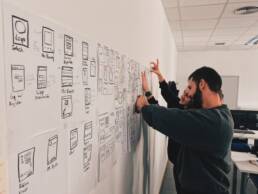AI, FROM SENTIMENT ANALYSIS TO PREVENTION OF DEPRESSION

AI, FROM SENTIMENT ANALYSIS TO PREVENTION OF DEPRESSION
Online and distance learning can reduce emotional feedback from learners and the perception of the class sentiment.
At the same time, teachers can have a lot of digital data, especially text, coming from students’ assignments, personal essays, diary entries and others. AI can support the analysis of this large amount of data and in case of need can help teachers to monitor and predict the class sentiment.
Sentiment analysis attempts to automatically identify and recognize opinions and emotions in text, identifying if it represents a positive or negative opinion. These kinds of AI tools recognise the most common expressions of emotion such as happiness, sadness, anger, etc. You can understand how sentiment analysis works by reading this paper.
You can try how these systems work using a simple demo for emotion analysis of texts such as Depechemood. You can type, copy/paste your text and get the related emotions.
These AI based technologies can be used, on the contrary, also for awareness raising processes on the others’ perception of some kind of sentences or texts. This can encourage, for example, good online behaviours, consciousness of others’ perception and even prevention of cyberbullying.
An exercise you can do with your students is to observe how perceived emotions change if you replace some words. This can demonstrate how some words can generate good or bad emotions.
A more sophisticated AI for text analysis, machine learning, was used with excellent results in detecting the presence of depression in people. Depression is noticeable in the way you speak and express yourself in writing. The main assumption, confirmed by several researchers, is that depression leads to clear and consistent differences in language between those with and without symptoms of depression.
A research, published in Clinical Psychological Science, identified specific classes of words that can help predict whether someone is suffering from depression. These results have been reached through the analysis of a huge amount of data, made possible by AI that can actually process extremely large data banks in minutes. This can help spot linguistic features which humans may miss, calculating the percentage prevalence of words and classes of words, lexical diversity, average sentence length, grammatical patterns, and many other metrics.
Other models such as this one published by MIT can detect words and intonations in conversations that may indicate depression. Although these methods are accurate, there’s a limit to them as they depend on specific answers to specific questions to make the diagnosis.
It would not be surprising to see the implementation of such a system in our schools in the near future.
For the next Erasmus+ call we are working on these topics. If you want to be our partner or have a proposal to be developed, get in touch.
Creative thinking: 5 tips for teachers and educators to make creative thinking part of their topic-based lessons

Creative thinking: 5 tips for teachers and educators to make creative thinking part of their topic-based lessons
What is creative thinking? What should teachers and educators do to make creative thinking part of their topic-based lessons?
Nowadays, when working in education and training environments, the word “creativity” is often associated with something that is necessary to develop higher-order thinking skills. Teachers, educators and trainers are asked to include creative thinking if they want to deliver relevant lessons for their students and, more importantly, if they want to ensure their engagement during the learning process.
What you don’t know is that creativity is already part of your teaching, without being aware of it! Every time you design and plan a lesson finding a way to engage your students to participate actively and take action, you are using creativity in your classroom.
But, in which way this can produce relevant results for your students?
Let’s start from the beginning.
There isn’t a common and shared definition about creativity. Some experts consider creativity focusing on cognition (creative thinking), others emphasise the importance of taking action, and, in this way, addressing real-world challenges.
Moreover, creativity appears in many different nuances as an ability, attitude, attribute, capability, capacity, character, cognitive, non-cognitive, life, meta, soft, transversal or twenty-first-century skill, core, key or knowledge.
There is a growing consensus that fostering creativity helps learners develop the skills associated with it, such as imagination, curiosity, the production of novelty and value, persistence, critical thinking and, almost always, collaboration.
That’s why creativity can’t be missed in your daily work in class.
From our experience, there are some tips you can follow to feel familiar with and to promote creativity in your classroom.
1.Link to the Learning Outcomes
Before thinking about your lesson, make sure you have already defined the Learning Outcomes (LOs) that your students are expected to achieve. We can’t arrange any activity without a clear reference to the specific competencies, skills and knowledge to be acquired by students.
Often, the initiatives focus on the creative process rather than the outcome. This will cause serious difficulties when you are going to assess students’ learning regarding creative thinking.
You should define LOs as a statement of what a learner is expected to know, understand, or be able to do at the end of a learning process.
Linking the activity to the LOs is extremely important to teachers and educators as it helps to identify, manage and assess creative thinking in students’ learning process.
2. Be informed
As you know pedagogical approaches used so far are very different from each other. This variety depends on context, resources, teachers’ proficiency, target group and more important, on LOs you want to achieve.
The most popular ones help create learning environments that reproduce the real world and include problem-based, game-based, experiential, and project-based learning.
Specific examples of approaches and methods employed are tinkering, five habits of mind, design thinking and collaborative challenge-based learning and so on.
Take your time to explore the topic through case studies, research, publications. Get inspired about projects or initiatives experienced around you, and why not, subscribe to training courses. The opportunities to get up-to-date knowledge are many and varied!
3. Work in a team
Considering the transversal dimension of creativity applied in teaching and learning settings, you may find useful to interact and discuss your work with your colleagues. Some subjects could be combined together into one activity in which creativity is not a goal in itself, but a means to address real-life problems, employability, or personal development.
The benefits of promoting an interdisciplinary approach for both teachers and students are well known. Don’t be afraid to try a new way!
4. Test with your students
You have developed a methodology, identifying Learning Outcomes, resources needed, the team, and the activities to be implemented. Great! Now, all that’s left is to test. Why? The methodology you want to propose is the right one but it may not work with your students.
Testing is different from assessing. Testing is a measuring tool. We can use a test, an examination, or a quiz to challenge the student’s ability or knowledge and to collect feedback to improve teaching methodology.
As we all know, changes are possible, and in many cases necessary, in order to adapt your theory to the actual development of the lessons.
5. Make your students part of the process
If you really want to assess your students and make it an active part of their own learning, promoting autonomy, they have to know, from the very beginning, about the assessment, the criteria you want to use, as well as about the examinations if there are going to be some.
You can find a variety of assessment tools, but to make the process more relevant for your students, don’t forget the following suggestions:
-Make the evaluation and marking criteria clear to your students. You can make them part of the process, for example creating grids or checklists together.
-Introduce peer evaluation and self-assessment.
-Be prepared to adapt your planning when necessary.
About this, lately, the Programme for International Student Assessment (PISA) has decided to make Creative Thinking the focus of its 2021 assessment (OECD, 2019) which confirms that creativity can be reliably assessed. If you want to know more about creativity, here you find a recent report published by the Joint Research Centre (JRC), the European Commission’s science and knowledge service.
For the next Erasmus+ call we are working on these topics. If you want to be our partner or have a proposal to be developed, get in touch.
Students online surveillance

Students online surveillance
Do you want to control your students? Do you think it is our role as educators? This is a very deep question linked to the meaning of education. Do we want to educate or teach?
According to UNESCO, at the end of April 2020, educational institutions shut down in 186 countries, affecting approximately 74% of total enrolled learners on the planet. COVID-19 pandemic forced schools to a quick transition to remote learning.
Many schools and especially US universities have increasingly used exam proctoring software to catch supposed cheaters. According to an Educause poll, 54 percent of higher education institutions are using online or remote proctoring services, while another 23 percent are considering or planning to use them. These systems offer different types of online proctoring such as:
- passive monitoring of software on students’ computer
- active restriction of software on students’ computer
- passive video surveillance of students
- active video surveillance of students
Softwares like ProctorU or Respondus must be installed on the students’ personal devices to monitor students while they take tests through biometric and environmental data such as:
- facial detection
- eye tracking (looking off screen consistently)
- head movement, mouse clicks, and scrolling rates that can be “anomalies” in metrics exhibiting behavior that differs from the class norm.
- lighting changes in the room
- unusual noises in the room
In combination with these programs schools or instructors often require students to do other actions such as 360-degree webcam scans of the rooms or hold hand mirrors up to their webcams prior to beginning a test to ensure they hadn’t written anything on the webcam and others.
This type of surveillance has become the new norm for tens of thousands of students around the world, who are forced to study remotely as a result of the COVID-19 pandemic.
You can see the exam guidelines provided by Wilfrid Laurier University (Canada) to their students.
Around this topic there is a heated debate between movements, raising the alarm about the dangers of invasive proctoring apps and proctoring companies and schools.
On the one hand...
Proctoring companies offer their services with the aim of reducing students cheating in online exams. They assume that the switch to remote learning provides new opportunities and motivations to cheat during tests and examinations.
Some studies highlighted the relevant percentage of students admitted to cheating on a test (64%) or participated in some form of cheating (95%). Schools are afraid this percentage will increase during unmonitored online tests, making cheating more common than it already is.
….On the other hand
Students are pushing school administrators and teachers to consider the risks of these apps through petitions across the globe.
Obviously privacy is a big concern. Students are watched and listened to in their homes while they take a test. Furthermore somebody may feel shame or discomfort about showing their living conditions to a stranger.
These apps increase anxiety to events which already are stressful for students. This can even affect their results.
Furthermore students with disabilities or other groups who already face barriers in education can have some problems.
Is this a normal transition and we have to get use of it or there is something affecting the students’ rights?
We think it is something that has to do with assessment methodologies in general. Schools, as usual, have simply substituted tools for a methodology change. To the sudden change of the situation due to the Covid-crisis they responded trying to control students instead of trusting them, using new tools (proctoring apps) with old methodologies (standard assessment).
On the contrary we should promote a radical change of the assessment methodologies based on students ownership and real acquisition of knowledge.
We can choose if we want to teach (from the latin insĭgnare - to leave marks) or educate (from the latin educere - to pull out, to breed).
For the next Erasmus+ call we are working on these topics. If you want to be our partner or have a proposal to be developed, get in touch.
What our students want - Did we turn our classroom into a cave?

What our students want - Did we turn our classroom into a cave?
One of the most important things to take into consideration, as educators and trainers, is to make lessons relevant for our students. It means to connect lessons to the real world, so as to boost students’ motivation and engagement. It gives students the opportunity to face real problems and be equipped with updated skills.
When I was a young student all adult people used to say: “ok, what you are doing at school is boring, it doesn’t make sense to you now, but in ten years it will be useful to find a well paid job”.
This way of thinking is unacceptable for today’s students for at least three reasons:
- 65% of children entering grade school today will end up working in jobs that don’t even exist yet.
- Some children and young students are actually impacting their local communities, countries and even the entire world becoming entrepreneurs, activists and media creators.
- Our students know all of this.
Students want to make the difference now, not in ten years, and we must give them the tools to do it.
If you don’t think your subject can have connections with the real world let’s see this inspiring interview with Eduardo Infante describing how “Philosophy in the street” began.
For non native Spanish speaking users here is the translation of the interview with Eduardo Infante in English language .
A good chance to put yourself into the students’ shoes is the virtual dialogue organized by Generation Unlimited on how young people and businesses can reimagine skills post-COVID-19.
They identified four important principles that should guide change of educational and training systems:
1. Updated curricula
There is a strong perception in young students that educational systems are outdated and cannot give them the right skills to compete in an international labour market. The new technologies are changing the working processes so fast that the only way to keep pace is that educators and companies work together in defining new curricula.
2. Focus more on soft skills than hard skills
Students are convinced that strong soft skills such as communication, critical thinking and resilience are the key for succeeding in future works. Soft skills can give an advantage regardless of the specific work and can foster change management and adaptation.
3. Digital learning is a reality
The Covid-19 crisis showed up the potential of digital education in terms of a reduction of the time needed for acquiring competences and better retention of the information. We must guarantee access to the internet and a proper digital literacy to everyone.
4. To guarantee access to everyone.
“It’s the notion of decentralising education and understanding that it doesn’t only happen in the classroom”. We must ensure the inclusion of the most disadvantaged students through innovative methodologies and synergies between educators and companies.
All these points are strongly related with the relevance we mentioned at the beginning. Some young people have the opportunity to make their dreams come true while others don’t. This is not only a matter of implementing innovative methodologies and tools or not. It is a matter of democracy of education, to give all students the possibility to impact the world.
For the next Erasmus+ call we are working on these topics. If you want to be our partner or have a proposal to be developed, get in touch.
How to run an online and blended Hackathon

How to run an online and blended Hackathon
Research suggests that “with this sudden shift away from the classroom activities in many parts of the globe, some are wondering whether the adoption of online learning will continue to persist post-pandemic, and how such a shift would impact the worldwide education market” (Sarhan, Abdulridha – 2020 – E-learning breaking time, Space and Pandemic).
“I believe that the integration of information technology in education will be further accelerated and that online education will eventually become an integral component of school education,“ says Wang Tao, Vice President of Tencent Cloud and Vice President of Tencent Education.
Experts agreed on the importance of building training and educational curricula by pushing for continuous curiosity, high-level creativity, and new experiences that enable students to learn how to learn and continue to apply that thought-process throughout their lives.
That is where the notion of Hackathons are a good platform to advocate for this change and are phenomenal examples of what education and training system should strive to encompass. They focus on a much more immersive way of learning. Not only do they promote the culture of technology, but they give students an opportunity to tackle these problems and develop new, practical and tangible knowledge.
In addition, the European Commission, through Digital Education Action Plan, boosts the role of the Digital Education Hackathon as the flagship event directly engaging those involved in delivering education and training programmes to foster innovation.
Hackathons can be presented as competitions, celebrations, or any number of other mechanisms that focus on participation for some desired purpose. They can easily run online or in a blended way ensuring the perfect balance between inclusion, tech, and participation.
In this article, you will find some suggestions on how to organise and deliver an online and blended Hackathon that could be included in your local or European educational project.
In order to make sure that the online event runs smoothly and that tasks are assigned properly within your team and the participants, you can use the following software that can help you to monitor the entire process:

The basic steps that a Hackathon should foresee are:
- Decide the purpose: Define the goal of organizing a Hackathon.
- Define the problem statement: What is the exact problem you are trying to solve or What do you want participants to build?
- Set the theme: Based on your problem statement, you define the specific theme that you want the participants to work with. Provide as much context and insights as possible for the participants.
- Make the rules: Define the parameters of your competition. Are teams allowed? How large can they be? Must participants use specific technology?
- Keep enough time to plan: Depending on the scale of the event, you need anywhere from four to eight weeks to properly plan for the event.
- Engage participants: Ensure your teams have people with different skills and from all levels to avoid groupthink and encourage networking and teamwork; diverse ideas spell quality.
- Make time for good breaks in between: Some engaging games or good food keep up the motivation levels and make sure that a good result is achieved.
- Decide on prizes or opportunities: Although the idea is to embed an innovation-driven culture in the organization, prizes (reward points, gift vouchers, incubation) always help.
- Wrap-up: After the Hackathon is over, share the videos of participant presentations or just make a final clip (for promoting your next hackathon). Gather your data and see if your goals were met; everyone needs to see measurable results.
Whether you are organizing an online Hackathon, remember to have: a clear purpose, a dedicated team and committed organisers.

Here you find some tools you can use during the organisation of the online Hackathon.
Preparation
- Google Hangouts: Easy link to spin up if you use the Google Suite
- Zoom: Allow participants to enter your Zoom room, you can share a screen and also record the session
Communication
- Slack: tool where you can create channels for different purposes so that participants can be notified with what is coming up on the agenda
- Discord: useful for sessions with hundreds of people, keep them informed, can do online chats, pinging mentors
Interactive Engagement
- Menti: easy, visual and compelling. Lots of features including ranking, quizzes, polls, word clouds, etc
- Slido: Use this if you want people to ask questions and vote on the questions/comments. The more votes it gets, the higher up the ranking it will go
- GitHub Student Developer Pack
Team Submissions and voting
- DevPost: You can see all the submissions that come through and judges can go in and vote based on customised criteria
- Google Forms: Put in your team’s group name, participants, and a link to what you have created over the period of time. Judges can go in and click on the links to either rank or score them
The European Commission promotes every year the DigiEduHack, which is a series of online and offline idea-hackathons happening all around the world for two days, focusing on co-creating the future of education in the digital age.
For the next Erasmus + call, we are working on these topics. If you want to be our partner or have a proposal to be developed, get in touch.
If your password is 123456 you must read this post

If your password is "123456" you must read this post
Globally, over 1.2 billion children are out of the classroom. As a result, education has changed dramatically, with the distinctive rise of e-learning, whereby teaching is undertaken remotely and on digital platforms.
With the explosion of distance and blended learning, online safety is becoming increasingly important. Our students are more engaged online than they’ve ever been and can be exposed to risks. The use of smart devices is increasing and the range of social media and platforms they are connecting to is expanding. One of the most challenging aspects of our modern digital lives is managing all the online accounts most of us now have.
Being safe and secure online has to be learnt and taught. It is extremely important to enhance cybersecurity in educational contexts, so to create safe environments for our students. To do that, we must follow two golden rules:
1. Don’t share your password with anyone
2. Always use cryptic passwords that can’t be easily guessed.
Regarding the second one, we are sure you would find the annual Nordpass report interesting and funny reading. In the last year they collected all data leaks of passwords on the internet in 2020 analysing how many times a password has been exposed, used, and how much time it would take to crack it.
“123456” is an evergreen that continues giving us great satisfaction. It is followed by “123456789” and “picture1”. The password “password” (LOL) is in fourth position.
In the first positions, you can find a big group of optimists selecting passwords such as “iloveyou” or “sunshine”, but also many athletes with “football” or “baseball”.
You can find the complete list here.

Let’s see now some simple rules to building good passwords:
1. Longer is better: your password should have more than eight characters and be a phrase. It could also be nonsense like mygardenhas9flowers.
2. Mix letters, numbers and characters: use a mix of lowercase and uppercase letters, and numbers and to add in some other characters
What you must avoid is to use single words.
A single word is very easy to be found by hackers. The entire vocabulary can be tested by automated software in a few seconds.


